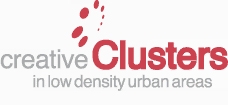
The starting assumption of the project is that creativity can act as a driving force for economic development of small urban centres and not only of big cities. Thus, the main value-added that the work of the Creative Clusters network can produce is to transfer the “creative city model” (too much focused on big and middle-sized metropolis) to low density urban areas. In other words, to transfer a range of so far considered urban attributes (accessibility, cultural life, technological facilities, competitive clusters, global networking, etc.) to middle-sized and small towns.
The idea behind the URBACT Creative Clusters project is that creativity can be a major driving force in the economic development of small urban centres. The nine partner cities in the project developed their Local Action Plans based on the model of larger “creative cities”, taking the ingredients needed for the development of a creative economy (cultural activities, high-tech installations, competitive clusters, partner networking, etc.) and transferring and adapting them to low urban density cities.

Main Results
Recommendations to create the conditions required for the development of a creative economy in cities with low urban density.
1. Providing a framework for creative industries by developing skills clusters.
The urban renewal potential and job creation offered by creativity industries should not be envisioned in an isolated manner, but rather through a new approach to the local economy that includes the creation of skills clusters. In Finland, the city of Jyväskylä decided to capitalise on creativity industries in order to improve quality of life and wellbeing. The Municipality also broadened the scope of possible application to other areas in the local economy (forestry industry, bioenergy, nanotechnologies, education, etc.).
Creativity and design should also be used to give a new boost to the growth of mature local industries. The city of Hódmezővásárhely, in Hungary, did this in the ceramics sector. The challenge is two-fold and entails promoting the creation of new skills clusters and working to boost already existing economic sectors by activating all the growth potential offered by creativity.
2. Attracting and retaining creative professionals
Local governments have a role to play in implementing specific measure to support entrepreneurs in the creative sector (financially, logistically and by providing consulting). Among the arsenal of measures available are reduced taxation, leasing and real estate support measures, financial tools such as capital risk, and the creation of a “business angel” network.
The concept of “alliances”, a recent innovation in European industrial policy, proves to be very useful for activities that are as integrated and emerging as the creativity industry. Concretely, it is a question of operating in a more open and horizontal way in order to build a closer relationship between innovation, its financing and cooperation.
3. New urban environments for creativity to bloom
In order to develop an effective strategy based on creativity, it is necessary to set up a space that is conducive to creation, and this needs to happen on several levels (from urban planning to architectural design).
In the area of urban planning, creativity can be a driving force for the renewal of city centres. This was, notably, the objective of the city of Terni, in Italy, which was connected to the URBACT Creative Clusters project, although it was not a partner. Among the other strategies that were implemented, we should note the creation of central squares (the city of Jyväskylä) and actions to promote a better connection between the city and the surrounding countryside (the city of Óbidos). Two factors are particularly important: continuity between the spaces devoted to professional creation and those devoted to private life, and a fair balance between trade, leisure, work and housing.
As for architectural design, a new trend is to emerging with installations that promote creativity. For example, there are business incubators, thematic business parks (the city of Viareggio), creation programmes in traditional business centres, artist residences, cultural installations (Casa da Musica in Porto), and alternative “low-cost” cultural spaces. Hybrid approaches, flexibility, interaction and experimentation are key to developing “creative” environments with the goal of reintroducing production sites into cities.
One of the key challenges is to avoid elitism. In isolated avant-garde neighbourhoods, it is preferable to promote “local creative ecosystems” whose functions are fully integrated into the city.
4. Creating bridges between culture and economic development
The cultural agenda is not only a tool for creativity; it can also play a role of catalyser or at least promote a local creative ecosystem. In this perspective, the local authorities have to ask the following questions: What cultural policy should we implement in order to promote cultural entrepreneurship? Are public commercial cultural sites well managed? Are they adapted to the demand and to the development of a creative economy?
In many cases, it is necessary to rethink the traditional approach that presides in terms of cultural events, and to innovate when it comes to objectives, formats and strategies.
5. Innovative education policies to drive the local creative ecosystem
At the city level, one notes a strong correlation between innovation in educational systems and the solidity of strategies that promote creativity. Cities such as Jyväskylä and Kortrijk led future talent incubation projects starting in school.
6. Administrating the local creative ecosystem
An effective strategy for a creative economy requires leadership and a shared vision. This leadership should evolve, with more active involvement and participation from stakeholders, and it should make it possible to deliver local policies and micro-projects designed on the basis of solid partnerships. The city of Kortrijk, in Belgium, is one example of this.
Finally, communication is an essential tool for disseminating strategies both inside and outside of cities. From this perspective, the creation of a brand should be perceived as a tool for promoting creativity rather than as an end in itself.
Read more
- Creative Clusters project mini-site - URBACT website
- Zoom on Jyväskylä - URBACT website
- Final report - Refreshing the local development agenda in small and medium-sized towns - PDF
106
documents in library
